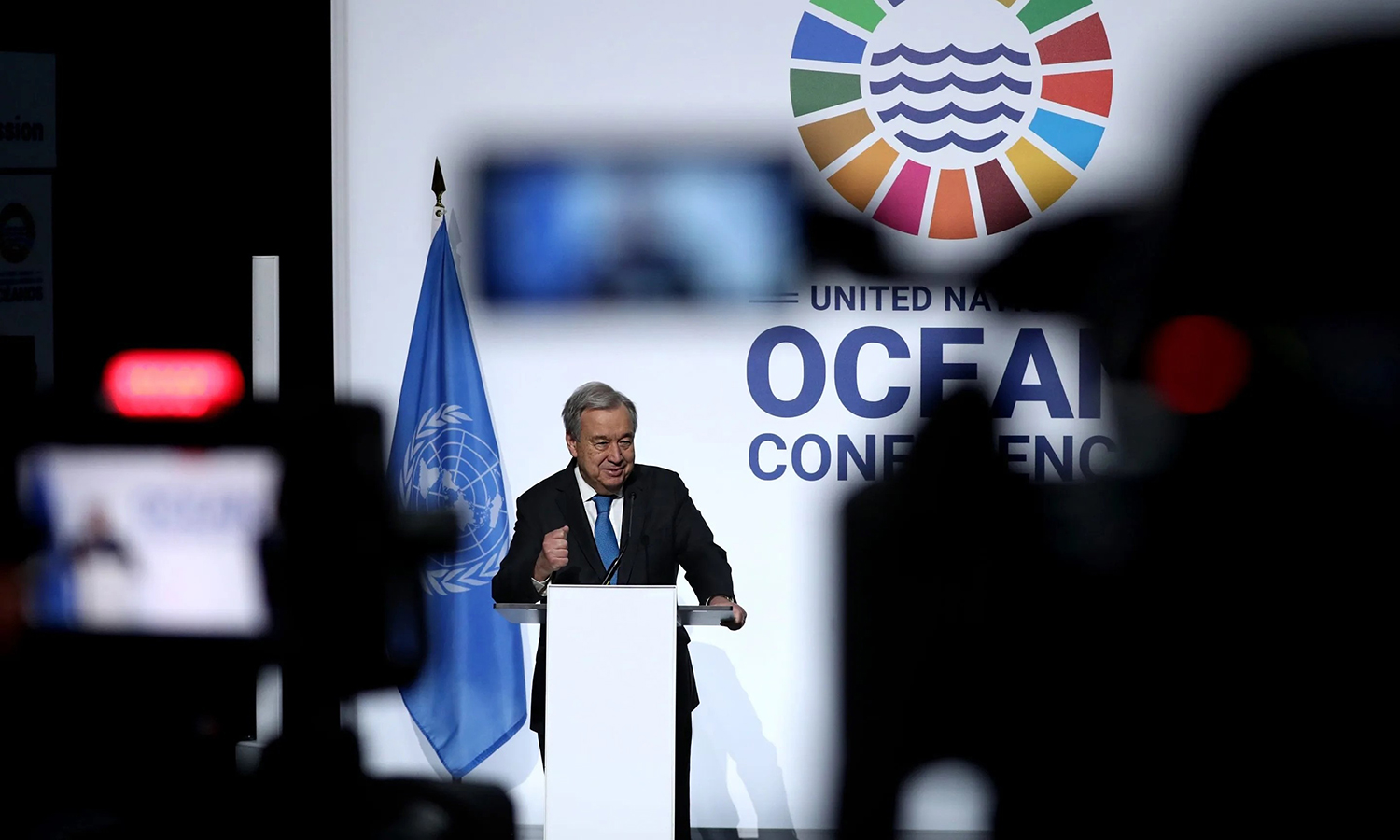
我们从海洋、河流、湖泊中生产或收获的食物到达了一个拐点。鱼类成为全世界交易量最高的大宗商品之一。水产养殖业是增长最快的食品工业。然而,这两个行业将迅速达到可持续发展的极限。
在经历过一连串聚焦于蓝色经济的全球事件之后,2022年联合国海洋大会(2022 UN Ocean Conference)于6月27日开幕,政策制定者们有一次绝佳的机会考虑一种截然不同的发展方式。全世界只有加大力度维护整个蓝色食品供应链的可持续性,才能够避开其他农产品行业遭遇的困境,使更多人可以充分利用蓝色食品,并避免资源枯竭或环境恶化。
虽然发达国家采取生态认证对改善生产标准做出了贡献,但各国政府部门不能局限于当前的指标,而是应该强烈建议整个行业,从环境、社会和经济等维度更加全面地思考可持续性。
可持续性首先要考虑到供应链中的生产者及其需求。依赖蓝色食品为生的8亿人,也是这个行业的基层工人,更是海洋和淡水生态系统健康的守护者。
当前的制度将数以百万计的小生产者排除在外。他们没有办法和资源承担昂贵的认证成本,达到认证的严格要求,但他们的缺位影响了整个行业,阻碍了实现真正可持续发展的进程。
随着更多人能够公平地参与蓝色食品价值链,包括女性,他们将得到激励和支持,为人类和环境创造更好的结果。
政策制定者可以支持这种积极转变,例如执行更好的措施保护包括原住民社区在内的本地人的权利和参与机会,制定包容性政策等。公共监管部门可以制定标准,限制恶性补贴,避免影响蓝色食品生产商采用更可持续的经营模式。
其次,蓝色食品行业实现长期可持续性的关键在于,提高供应多样化,避免过度依赖虾、鲑鱼和金枪鱼等种类。多样化的供应链不仅对全世界最大程度提高生活水准和食品安全至关重要,而且软体类水产、海藻和小型鱼类等物种还有更多营养价值。
超过3700种水生物种均含有不同程度的维生素、矿物质和脂肪酸,大幅增加水生物种的供应多样化,预计能够让1.66亿人避免微量营养素缺乏。
与此同时,许多蓝色食品的环境影响与鸡肉相当甚至更加出色,海藻和双壳类动物,比如贻贝、生蚝等,所产生的温室气体排放最低。
最后,政策制定者还必须考虑如何确保全球和本地蓝色食品市场能够支持可持续生产、分销和在对蓝色食品需求最大的领域的可及性,包括学校供餐项目和本地贸易网络等机制。
有40%的鱼类被用于国际贸易,因此依赖蓝色食物维持生计和获取营养的沿海社区,必须能够参与贸易并从中受益,以确保全球市场不会夺走穷人的营养来源,或者破坏他们赖以生存的生态环境。
此外,小型企业可以产生足够的经济效益,因此它们依旧能够参与该行业并为其做出贡献。例如,通过投资为小企业创造更多的机会,通过将蓝色食品加工成更高附加值产品从中获利,还可以从全球市场中获得溢价,增加本地水产养殖价值链的生计。
通过执行恰当的政策,能够引导最有影响力的企业重新定义可持续性:使小型生产商、加工商和贸易商、沿海和原住民社区,以及发展中国家都可以从中受益。(财富中文网)
本文作者菲奥伦扎·米凯利(Fiorenza Micheli)是斯坦福大学海洋解决方案中心(Stanford Center for Ocean Solutions)和霍普金斯海洋站(Hopkins Marine Station)的联席主任,也是蓝色食品评估(Blue Food Assessment)倡议的成员。
在Fortune.com上发表的评论文章中表达的观点,仅代表作者本人的观点,不代表《财富》杂志的观点和立场。
译者:刘进龙
审校:汪皓
我们从海洋、河流、湖泊中生产或收获的食物到达了一个拐点。鱼类成为全世界交易量最高的大宗商品之一。水产养殖业是增长最快的食品工业。然而,这两个行业将迅速达到可持续发展的极限。
在经历过一连串聚焦于蓝色经济的全球事件之后,2022年联合国海洋大会(2022 UN Ocean Conference)于6月27日开幕,政策制定者们有一次绝佳的机会考虑一种截然不同的发展方式。全世界只有加大力度维护整个蓝色食品供应链的可持续性,才能够避开其他农产品行业遭遇的困境,使更多人可以充分利用蓝色食品,并避免资源枯竭或环境恶化。
虽然发达国家采取生态认证对改善生产标准做出了贡献,但各国政府部门不能局限于当前的指标,而是应该强烈建议整个行业,从环境、社会和经济等维度更加全面地思考可持续性。
可持续性首先要考虑到供应链中的生产者及其需求。依赖蓝色食品为生的8亿人,也是这个行业的基层工人,更是海洋和淡水生态系统健康的守护者。
当前的制度将数以百万计的小生产者排除在外。他们没有办法和资源承担昂贵的认证成本,达到认证的严格要求,但他们的缺位影响了整个行业,阻碍了实现真正可持续发展的进程。
随着更多人能够公平地参与蓝色食品价值链,包括女性,他们将得到激励和支持,为人类和环境创造更好的结果。
政策制定者可以支持这种积极转变,例如执行更好的措施保护包括原住民社区在内的本地人的权利和参与机会,制定包容性政策等。公共监管部门可以制定标准,限制恶性补贴,避免影响蓝色食品生产商采用更可持续的经营模式。
其次,蓝色食品行业实现长期可持续性的关键在于,提高供应多样化,避免过度依赖虾、鲑鱼和金枪鱼等种类。多样化的供应链不仅对全世界最大程度提高生活水准和食品安全至关重要,而且软体类水产、海藻和小型鱼类等物种还有更多营养价值。
超过3700种水生物种均含有不同程度的维生素、矿物质和脂肪酸,大幅增加水生物种的供应多样化,预计能够让1.66亿人避免微量营养素缺乏。
与此同时,许多蓝色食品的环境影响与鸡肉相当甚至更加出色,海藻和双壳类动物,比如贻贝、生蚝等,所产生的温室气体排放最低。
最后,政策制定者还必须考虑如何确保全球和本地蓝色食品市场能够支持可持续生产、分销和在对蓝色食品需求最大的领域的可及性,包括学校供餐项目和本地贸易网络等机制。
有40%的鱼类被用于国际贸易,因此依赖蓝色食物维持生计和获取营养的沿海社区,必须能够参与贸易并从中受益,以确保全球市场不会夺走穷人的营养来源,或者破坏他们赖以生存的生态环境。
此外,小型企业可以产生足够的经济效益,因此它们依旧能够参与该行业并为其做出贡献。例如,通过投资为小企业创造更多的机会,通过将蓝色食品加工成更高附加值产品从中获利,还可以从全球市场中获得溢价,增加本地水产养殖价值链的生计。
通过执行恰当的政策,能够引导最有影响力的企业重新定义可持续性:使小型生产商、加工商和贸易商、沿海和原住民社区,以及发展中国家都可以从中受益。(财富中文网)
本文作者菲奥伦扎·米凯利(Fiorenza Micheli)是斯坦福大学海洋解决方案中心(Stanford Center for Ocean Solutions)和霍普金斯海洋站(Hopkins Marine Station)的联席主任,也是蓝色食品评估(Blue Food Assessment)倡议的成员。
在Fortune.com上发表的评论文章中表达的观点,仅代表作者本人的观点,不代表《财富》杂志的观点和立场。
译者:刘进龙
审校:汪皓
The food we produce or harvest from the oceans, rivers, and lakes is at an inflection point. Fish has become one of the most traded commodities in the world. Aquaculture is the fastest-growing food industry. However, both sectors are rapidly approaching the limits of sustainability.
With the UN Ocean Conference getting underway this week in Lisbon after a string of global events focused on the blue economy, policymakers have a unique window of opportunity to consider an entirely different approach. Only by ambitiously entrenching the sustainability of blue foods across supply chains will the world be able to avoid the pitfalls of other agri-food sectors and enable more people to get the best out of blue foods, without exhausting these resources or degrading the environment.
While eco-certification has made an important contribution towards improving production standards in the Global North, governments and agencies worldwide must move beyond current metrics and challenge the entire sector to think more comprehensively about sustainability to include environmental, social, and economic dimensions.
Sustainability must start where supply chains do: with the producers and their needs. The 800 million men and women who depend on blue foods for their livelihoods are also the sector’s frontline workers and the stewards of marine and freshwater ecosystem health.
Current schemes exclude millions of small-scale producers who lack the means and resources to bear the high costs of certification and meet its stringent bar, but their absence undermines the sector at large and hinders progress towards true sustainability.
With more of the diverse actors in the blue food value chain–including women–able to participate more equitably, they will be incentivized and supported to create better outcomes for people and the environment.
Policymakers can support this positive transformation by implementing better protections for local rights and access, including those of indigenous communities, and inclusive policies. Public regulators can introduce standards to limit harmful subsidies that undermine the ability of blue food producers to adopt more sustainable practices.
Secondly, the long-term sustainability of the blue food sector hinges on increasing the diversity in supply to avoid the dangers of an over-reliance on shrimp, salmon, and tuna. Not only is a diverse supply chain critical for maximizing the potential for decent livelihoods and food security around the world, but it also unlocks a greater range of nutritional benefits from species like mollusks, seaweed, and small fish.
With more than 3,700 aquatic species all containing different levels of vitamins, minerals, and fatty acids, sustainably increasing and diversifying supply could prevent micronutrient deficiencies for a projected 166 million people.
Meanwhile, many blue foods outperform or compare to chicken in terms of environmental impact, with seaweeds and bivalves like mussels and oysters generating the lowest levels of greenhouse gas emissions.
Finally, policymakers must also consider how to ensure global and local markets for blue foods support the sustainable production, distribution, and availability of blue foods where they are most needed, including mechanisms such as school feeding programs and local trade networks.
With as much as 40% of fish traded internationally, coastal communities who depend on blue foods for their livelihoods and nutrition must be enabled to participate and benefit to ensure global markets are not taking nutrients from the mouths of the poor or degrading the ecosystems that are essential to their livelihoods.
It is also critical that small-scale actors can reap adequate economic benefits so that they can remain engaged and contribute to the sector. For example, investing in more opportunities for small-scale operations to also benefit from processing blue foods into higher-value products, which often attract a premium from global markets, will increase the livelihoods of local aquaculture value chains.
With the right policies, the most powerful players can be directed towards a new definition of sustainability: one that also allows small-scale producers, processors and traders, coastal and indigenous communities, and developing countries to benefit.
Fiorenza Micheli is the co-director of the Stanford Center for Ocean Solutions and Hopkins Marine Station and a member of the Blue Food Assessment initiative.
The opinions expressed in Fortune.com commentary pieces are solely the views of their authors and do not reflect the opinions and beliefs of Fortune.






